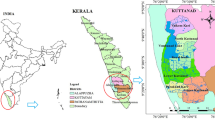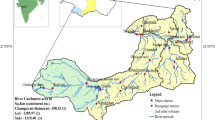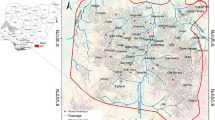Abstract
Climate change is responsible for triggering one of the most destructive natural disasters known as flooding. The flood risk index quantifies the vulnerability of an area to flooding, providing valuable insights for mitigation and preparedness efforts. Flood risk index integrates factors, aiding understanding and fostering resilient communities. This study uses an integrated strategy of geospatial technology and multi-criteria decision analysis to produce a map of the flood risk index for a data scarce region. Through this research work, fifteen thematic maps (i.e., Lithology, Soil, Slope, Drainage Density, Land use and Land cover, Rainfall, Distance from river, Permeability, Runoff, Normalized Difference Vegetation Index, Normalized Difference Built-up Index, Modified Normalized Difference Water Index, Topographic Wetness Index, Profile and Plan Curvature) in case of flood hazard index and three thematic maps (i.e., Population density, Crop production and Road river interaction) in case of flood vulnerability index were used. Thematic maps checked for multicollinearity, overlaid in ArcGIS with ranked assignments using AHP to develop flood hazard and vulnerability maps. The flood risk map was developed by integrating the flood hazard and vulnerability maps. The research region divided into five categories based on flood risk index map: very low (8%), low (28%), moderate (16%), high (20%), and very high (28%). The regions such as Vangara, Pathapatnam, Tekkali, Kusumala, Ichapuram shows very high tendency towards flood risk. This was due to favorable factors such as high/ moderate runoff, slope (very gentle/ gentle), very low/ low permeability, lithology (granite/ gneiss) etc. of the research region.


























Similar content being viewed by others
Data availability
The submitted article contains all of the data and models developed or utilized during the study. There is no separate data available with this manuscript.
References
Abu El-Magd, S. A., Amer, R. A., & Embaby, A. (2020). Multi-criteria decision-making for the analysis of flash floods: A case study of Awlad Toq-Sherq, Southeast Sohag, Egypt. Journal of African Earth Sciences, 162, 103709. https://doi.org/10.1016/j.jafrearsci.2019.103709
Amare, G. N., & Okubay, G. A. (2019). Flood hazard risk vulnerability mapping using Geo-spatial and MCDA around Adigrat, Tigray Region, Northern Ethiopia. Momona Ethiopian Journal of Science, 7(1), 90–107. https://doi.org/10.4314/mejs.v11i1.6
Arrighi, C. (2021). A global scale analysis of river flood risk of UNESCO world heritage sites. Frontiers in Water, 3, 1–12. https://doi.org/10.3389/frwa.2021.764459
Arya, A. K., & Singh, A. P. (2021). Multi criteria analysis for flood hazard mapping using GIS techniques: A case study of Ghaghara River basin in Uttar Pradesh, India. Arabian Journal of Geosciences, 14(8), 1–12. https://doi.org/10.1007/s12517-021-06971-1
Baquedano, J. A. P., & Ferreira, T. M. (2021). From single- to multi-hazard vulnerability and risk in historic urban areas: A literature review. Natural Hazards, 108, 93–128. https://doi.org/10.1007/s11069-021-04734-5
Bonazza, A., Maxwell, I., Drd, A. M., Vintzileou, E., & Hanus, C. (2018). Safeguarding cultural heritage from natural and manmade disasters—A comparative analysis of risk management in the EU. European Commission. https://publications.europa.eu/en/publicationdetail/-/publication/8fe9ea60-4cea-11e8-be1d-01aa75ed71a1/language-en
Chakraborty, S., & Mukhopadhyay, S. (2019). Assessing flood risk using analytical hierarchy process (AHP) and geographical information system (GIS): Application in Coochbehar district of West Bengal, India. Natural Hazards, 99(1), 247–274. https://doi.org/10.1007/s11069-019-03737-7
Chen, H., Liang, Z., Liu, Y., Jiang, Q., & Xie, S. (2018). Effects of drought and flood on crop production in China across 1949–2015: Spatial heterogeneity analysis with Bayesian hierarchical modeling. Natural Hazards, 92, 525–541. https://doi.org/10.1007/s11069-018-3216-0
Dayala, D., Wang, K., Yan, Y., Smith, H., Massam, A., Filipova, V., & Jacqueline, P. J. (2020). Flood vulnerability and risk assessment of urban traditional buildings in a heritage district of Kuala Lumpur, Malaysia. Natural Hazards and Earth System Sciences, 20(8), 2221–2241. https://doi.org/10.5194/nhess-20-2221-2020
Desalegn, H., & Mulu, A. (2020). Flood vulnerability assessment using GIS at Fetam watershed, upper Abbay basin, Ethiopia. Heliyon, 7, 05865. https://doi.org/10.1016/j.heliyon.2020.e05865
Doorga, J. R. S., Magerl, L., Bunwaree, P., Zhao, J., Watkins, S., Staub, C. G., Rughooputh, S. D. D. V., Cundenn, T. S. M., Lollchund, R., & Boojhawon, R. (2022). GIS-based multi-criteria modelling of flood risk susceptibility in Port Louis, Mauritius: Towards resilient flood management. International Journal of Disaster Risk Reduction, 67, 102683. https://doi.org/10.1016/j.ijdrr.2021.102683
Ehteram, M., Ahmed, A. N., Chow, M. F., Latif, S. D., Chau, K. W., Chong, K. L., & El-Shafie, A. (2022). Optimal operation of hydropower reservoirs under climate change. Environment, Development and Sustainability, 25, 10627–10659. https://doi.org/10.1007/s10668-022-02497-y
Ferreira, T. M., & Santos, P. P. (2020). An integrated approach for assessing flood risk in historic city centres. Water, 12(6), 1648. https://doi.org/10.3390/w12061648
Gandini, A., Garmendia, L., Prieto, I., Alvarez, I., & San-Jose, J. T. (2020). A holistic and multi-stakeholder methodology for vulnerability assessment of cities to flooding and extreme precipitation events. Sustainable Cities and Society, 63, 102437. https://doi.org/10.1016/j.scs.2020.102437
Gazi, Y., Islam, A., & Hossai, S. (2019). Flood-hazard mapping in a regional scale-way forward to the future hazard Atlas in Bangladesh. Malaysian Journal Geosciences, 3(1), 01–1. https://doi.org/10.26480/mjg.01.2019.01.11
Hermas, E., Gaber, A., & Bastawesy, M. E. (2021). Application of remote sensing and GIS for assessing and proposing mitigation measures in flood-affected urban areas, Egypt. The Egyptian Journal of Remote Sensing and Space Science, 24(1), 119–130. https://doi.org/10.1016/j.ejrs.2020.03.002
Hussain, M., Tayyab, M., Zhang, J., Shah, A. A., Ullah, K., Mehmood, U., & AlShaibah, B. (2021). GIS-Based multi-criteria approach for flood vulnerability assessment and mapping in district Shangla: Khyber Pakhtunkhwa Pakistan. Sustainability, 13, 3126. https://doi.org/10.3390/su13063126
Khosravi, K., Shahabi, H., Pham, B. T., Adamowski, J., Shirzadi, A., Pradhan, B., Dou, J., Ly, H., Gróf, G., Ho, H. L., Hong, H., Chapi, K., & Prakash, I. (2019). A comparative assessment of flood susceptibility modeling using Multi-Criteria Decision-Making Analysis and Machine Learning Methods. Journal of Hydrology, 573, 311–323. https://doi.org/10.1016/j.jhydrol.2019.03.073
Kienberger, S., Lang, S., & Zeil, P. (2009). Spatial vulnerability units: Expert-based spatial modelling of socio-economic vulnerability in the Salzach catchment, Austria. Natural Hazards and Earth Systems Sciences, 9, 767–778. https://doi.org/10.5194/nhess-9-767-2009
Lai, V., Huang, Y. F., Koo, C. H., Ahmed, A. N., & El-Shafie, A. (2022). Conceptual Sim-Heuristic optimization algorithm to evaluate the climate impact on reservoir operations. Journal of Hydrology, 614(A), 128530. https://doi.org/10.1016/j.jhydrol.2022.128530
Martinez-Gomariz, E., Forero-Ortiz, E., Russo, B., Locatelli, C., Guerrero-Hidalga, M., Yubero, D., & Castand, S. (2021). A novel expert opinion-based approach to compute estimations of flood damage to property in dense urban environments. Barcelona case study. Journal of Hydrology, 598, 126244. https://doi.org/10.1016/j.jhydrol.2021.126244
Memon, N., Patel, D. P., Bhatt, N., & Patel, S. B. (2020). Integrated framework for flood relief package (FRP) allocation in semiarid region: A case of Rel River flood, Gujarat, India. Natural Hazards, 100, 279–311. https://doi.org/10.1007/s11069-019-03812-z
Merz, B., Bloschl, G., Vorogushyn, S., Dottori, F., Aerts, J. C. J. H., Bates, P., Bertola, M., Kemter, M., Kreibich, H., Lall, U., & Macdonald, E. (2021). Causes, impacts and patterns of disastrous river floods. Nature Reviews Earth and Environment, 2(9), 592–609. https://doi.org/10.1038/s43017-021-00195-3
Miranda, F. N., & Ferreira, T. M. (2019). A simplified approach for flood vulnerability assessment of historic sites. Natural Hazards, 96(2), 713–730. https://doi.org/10.1007/s11069-018-03565-1
Montgomery, D. C., Peck, E. A., & Vining, G. G. (2013). Introduction to Linear Regression Analysis (5th ed.). New Jersey: Wiley.
Morea, H., & Samanta, S. (2020). Multi-criteria decision approach to identify flood vulnerability zones using geospatial technology in the kemp-welch catchment, Central province. Applied Geomatics, 12(4), 427–440. https://doi.org/10.1007/s12518-020-00315-6
Mundhe, N. (2019). Multi-criteria decision making vulnerability mapping of flood hazard: A case study Pune city. Journal of Geographical Studies, 2(1), 41–52. https://doi.org/10.21523/gcj5.18020105
Nasiri, H., Mohd, Y. M. J., & Mohammad, A. T. A. (2016). An overview to flood vulnerability assessment methods. Sustainable Water Resources Management, 2(3), 331–336. https://doi.org/10.1007/s40899-016-0051-x
Ogato, G. S., Bantider, A., Abebe, K., & Geneletti, D. (2020). Geographic information system (GIS)–based multi criteria analysis of flooding hazard and risk in Ambo Town and its watershed, West shoa zone, Oromia regional State Ethiopia. Journal of Hydrology: Regional Studies, 27, 100659. https://doi.org/10.1016/j.ejrh.2019.10
Palacio-Aponte, A. G., Ortíz-Rodríguez, A. J., & Sandoval-Solis, S. (2022). Methodological framework for territorial planning of urban areas: Analysis of socio-economic vulnerability and risk associated with flash flood hazards. Applied Geography, 149, 102809. https://doi.org/10.1016/j.apgeog.2022.102809
Petroselli, A., Vojtek, M., & Vojtekova, J. (2019). Flood mapping in small ungauged basins: A comparison of different approaches for two case studies in Slovakia. Hydrology Research, 50, 379–392. https://doi.org/10.2166/nh.2018.040
Polong, F., Deng, K., Pham, Q. B., Linh, N. T. T., Abba, S. I., Ahmed, A. N., Anh, D. T., Khedher, K. M., & El-Shafie, A. (2023). Separation and attribution of impacts of changes in land use and climate on hydrological processes. Theoretical and Applied Climatology, 151, 1337–1353. https://doi.org/10.1007/s00704-022-04351-7
Prieto, C., Patel, D., & Han, D. (2020). Preface: Advances in flood risk assessment and management. Natural Hazards and Earth Systems Sciences, 20, 1045–1048. https://doi.org/10.5194/nhess-20-1045-2020
Quinn, N., Bates, P. D., Neal, J., Smith, A., Wing, O., Sampson, C., Smith, J., & Heffernan, J. (2019). The spatial dependence of flood hazard and risk in the United States. Water Resources Research, 55, 1–22. https://doi.org/10.1029/2018WR024205
Ray, S. K. (2023). Identifying the groundwater potential zones in Jamsholaghat sub-basin by considering GIS and multi-criteria decision analysis. International Journal of Environmental Science and Technology. https://doi.org/10.1007/s13762-023-04923-8
Requena, A. I., Ouarda, T. B. M. J., & Chebana, F. (2018). Low-flow frequency analysis at ungauged sites based on regionally estimated stream flows. Journal of Hydrology, 563, 523–532. https://doi.org/10.1016/j.jhydrol.2018.06.016
Rincon, D., Khan, U. T., & Armenakis, C. (2018). Flood risk mapping using GIS and multi-criteria analysis: A greater Toronto area case study. Geosciences, 8, 275. https://doi.org/10.3390/geosciences8080275
Saaty, R. W. (1987). The analytic hierarchy process-what it is and how it is used. Mathematical Modeling, 9, 161–176. https://doi.org/10.1016/0270-0255(87)90473-8
Saaty, T. L. (1990). How to make a decision: The analytic hierarchy process. European Journal of Operational Research, 48, 9–26. https://doi.org/10.1016/0377-2217(90)90057-I
Saaty, T. L. (2008). Decision making with the analytic hierarchy process. International Journal of Services Sciences., 1(1), 83–98. https://doi.org/10.1504/IJSSCI.2008.017590
Samela, C. R., Sole, A., & Manferda, S. (2018). A GIS tool for cost-effective delineation of flood-prone areas. Computers, Environment and Urban Systems, 70, 43–52. https://doi.org/10.1016/j.compenvurbsys.2018.01.013
Schroeder, A. J., Gourley, J. J., Hardy, J., Henderson, J. J., Parhi, P., Rahmani, V., Reed, K. A., Schumacher, R. S., Smith, B. K., & Taraldsen, M. J. (2016). The development of a flash flood severity index. Journal of Hydrology, 541(A), 523–532. https://doi.org/10.1016/j.jhydrol.2016.04.005
Shahabi, H., Shirzadi, A., Ronoud, S., Asadi, S., Pham, B. T., Mansouripour, F., Geertsema, M., Clague, J. J., & Bui, D. T. (2021). Flash flood susceptibility mapping using a novel deep learning model based on deep belief network, back propagation and genetic algorithm. Geoscience Frontiers, 12(3), 101100. https://doi.org/10.1016/j.gsf.2020.10.007
Singh, A. P., Arya, A. K., & Singh, D. S. (2020). Morphometric analysis of Ghaghara River basin, India, using SRTM data and GIS. Journal of the Geological Society of India, 95(2), 169–178. https://doi.org/10.1007/s12594-0201406-3
Solomun, M. K., Ferreira, C. S. S., Zupanc, V., Ristic, R., Drobnjak, A., & Kalantari, Z. (2021). Flood legislation and land policy framework of EU and non-EU countries in Southern Europe. WIREs, 9(1), e1566. https://doi.org/10.1002/wat2.1566
Teng, J., Jakeman, A. J., Vaze, J., Croke, B. F. W., Dutta, D., & Kim, S. (2017). Flood inundation modelling: A review of methods, recent advances and uncertainty analysis. Environmental Modelling and Software, 90, 201–216. https://doi.org/10.1016/j.envsoft.2017.01.006
Velasco, M., Cabello, À., & Russo, B. (2016). Flood damage assessment in urban areas. Application to the Raval district of Barcelona using synthetic depth damage curves. Urban Water Journal, 13, 426–440. https://doi.org/10.1080/1573062X.2014.994005
Vojtek, M., & Vojtekova, J. (2019). Flood susceptibility mapping on a national scale in Slovakia using the analytical hierarchy process. Water, 11, 364. https://doi.org/10.3390/w11020364
Vörösmasrty, C. J., Léveque, C., Revenga, C., Bos, R., Caudill, C., Clinton, J., Douglas, E. M., Nilsson, C., Oki, T., Reidy, C. A., Rijsberman, F., Costanza, R., & Jacobi, P. (2005). Fresh water. In R. Hassan, R. Scholes, & N. Ash (Eds.), Ecosystems and human well-being: current state and trends (Vol. 1, p. 917). Washington DC: Millennium Ecosystem Assessment.
Xiao, S., Li, N., & Guo, X. (2021). Analysis of flood impacts on masonry structures and mitigation measures. Journal of Flood Risk Management, 14(4), e12743. https://doi.org/10.1111/jfr3.12743
Yang, W., Xu, K., Lian, J., Ma, C., & Bin, L. (2018). Integrated flood vulnerability assessment approach based on TOPSIS and Shannon entropy methods. Ecological Indicators, 89, 269–280. https://doi.org/10.1016/j.ecolind.2018.02.015
Funding
No funding was obtained for this study.
Author information
Authors and Affiliations
Contributions
The author contributed to the study conception, design, material preparation, data collection and analysis. The first draft of the manuscript was written by Dr. Sanjay Ku. Ray. The author read and approved the final manuscript.
Corresponding author
Ethics declarations
Conflict of interest
The authors declare that there is no known competing financial interests or personal relationships that could have appeared to influence the work reported in this paper. The author has no conflicts of interest to declare.
Additional information
Publisher's Note
Springer Nature remains neutral with regard to jurisdictional claims in published maps and institutional affiliations.
Rights and permissions
Springer Nature or its licensor (e.g. a society or other partner) holds exclusive rights to this article under a publishing agreement with the author(s) or other rightsholder(s); author self-archiving of the accepted manuscript version of this article is solely governed by the terms of such publishing agreement and applicable law.
About this article
Cite this article
Ray, S.K. Flood risk index mapping in data scarce region by considering GIS and MCDA (FRI mapping in data scarce region by considering GIS and MCDA). Environ Dev Sustain (2024). https://doi.org/10.1007/s10668-024-04641-2
Received:
Accepted:
Published:
DOI: https://doi.org/10.1007/s10668-024-04641-2




